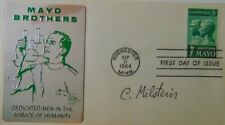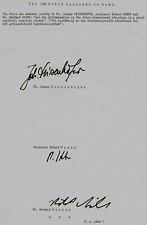RARE "Nobel Prize in Medicine" Martin Rodbell Hand Signed 3X5 Card For Sale

When you click on links to various merchants on this site and make a purchase, this can result in this site earning a commission. Affiliate programs and affiliations include, but are not limited to, the eBay Partner Network.
RARE "Nobel Prize in Medicine" Martin Rodbell Hand Signed 3X5 Card:
$349.99
Up for sale a VERY RARE! "Nobel Prize in Medicine" Martin Rodbell Hand Signed 3X5 Card.
ES-4441
Martin Rodbell (December
1, 1925 – December 7, 1998) was is best known for his discovery
of G-proteins. He shared the 1994 Nobel Prize
in Physiology or Medicine with Alfred G. Gilman for "their discovery of G-proteins
and the role of these proteins in signal transduction in cells." Rodbell
was born in Baltimore, Maryland, the
son of Shirley (née Abrams) and Milton Rodbell, a grocer.[2] His family was Jewish. After
graduating from the Baltimore City College high
school, he entered Johns Hopkins University in
1943, with interests in biology and French existential literature. In 1944, his studies were
interrupted by his military service as a U.S. Navy radio operator during World War II. He returned to Hopkins in 1946 and received his
B.S. in biology in 1949. In 1950, he married Barbara Charlotte
Ledermann, a former friend of the legendary diarist Anne Frank, with whom he had four children. Rodbell received
his Ph.D. of Washington in
1954. He did post-doctoral work at the University
of Illinois at Urbana-Champaign from 1954 to 1956. In 1956,
Rodbell accepted a position as a research biochemist at the National Heart
Institute, part of the National Institutes of
Health, in Bethesda, Maryland. In
1985, Rodbell became Scientific Director of the NIH's National Institute of
Environmental Health Sciences in Research
Triangle Park, North Carolina where he worked until his
retirement in 1994. He was also Adjunct Professor of Cell Biology at Duke University (from 1991 to 1998) and Adjunct Professor of
Pharmacology at the University
of North Carolina at Chapel Hill.[5][6] He died in Chapel Hill of multiple
organ failure after an extended illness. Reflecting the increasingly common
analogies between computer science and biology in the 1960s, Rodbell believed that the
fundamental information processing systems of both computers and
biological organisms were similar. He asserted
that individual cells were analogous to cybernetic systems made up of three
distinct molecular components: discriminators, transducers, and amplifiers (otherwise known as effectors). The
discriminator, or cell receptor, receives
information from outside the cell; a cell transducer processes
this information across the cell membrane; and the amplifier intensifies these signals to
initiate reactions within the cell or to transmit information to other cells. In
December 1969 and early January 1970, Rodbell was working with a laboratory
team that studied the effect of the hormone glucagon on a cellular discriminator that receives outside signals. Rodbell
discovered that ATP (adenosine triphosphate) could reverse the binding action of
glucagon to the cell receptor and thus dissociate the glucagon from the cell
altogether. He then noted that traces of GTP (guanosine triphosphate)
could reverse the binding process almost one thousand times faster than ATP.
Rodbell deduced that GTP was probably the active biological factor in
dissociating glucagon from the cell's receptor, and that GTP had been present
as an impurity in his earlier experiments with ATP. This GTP, he found,
stimulated the activity in the guanine nucleotide protein (later called the
G-protein), which, in turn, produced profound metabolic effects in the cell.
This activation of the G-protein, Rodbell postulated, was the "second messenger" process that Earl W. Sutherland had
theorized. In the language of signal transduction, the G-protein, activated by
GTP, was the principal component of the transducer, which was the crucial link
between the discriminator and the amplifier. Later, Rodbell postulated, and
then provided evidence for, additional G-proteins at the cell receptor that
could inhibit and activate transduction, often at the same time. In other
words, cellular receptors were sophisticated enough to have several different
processes going on simultaneously.

Related Items:
RARE “Nobel Peace Prize" Ralph Bunche Hand Signed 3X5 Card COA
$139.99
RARE "Nobel Prize in Medicine" César Milstein Hand Signed FDC Dated 1964
$349.99
RARE" Nobel Prize Laureates" Signed (X3) Information Sheet
$489.99



